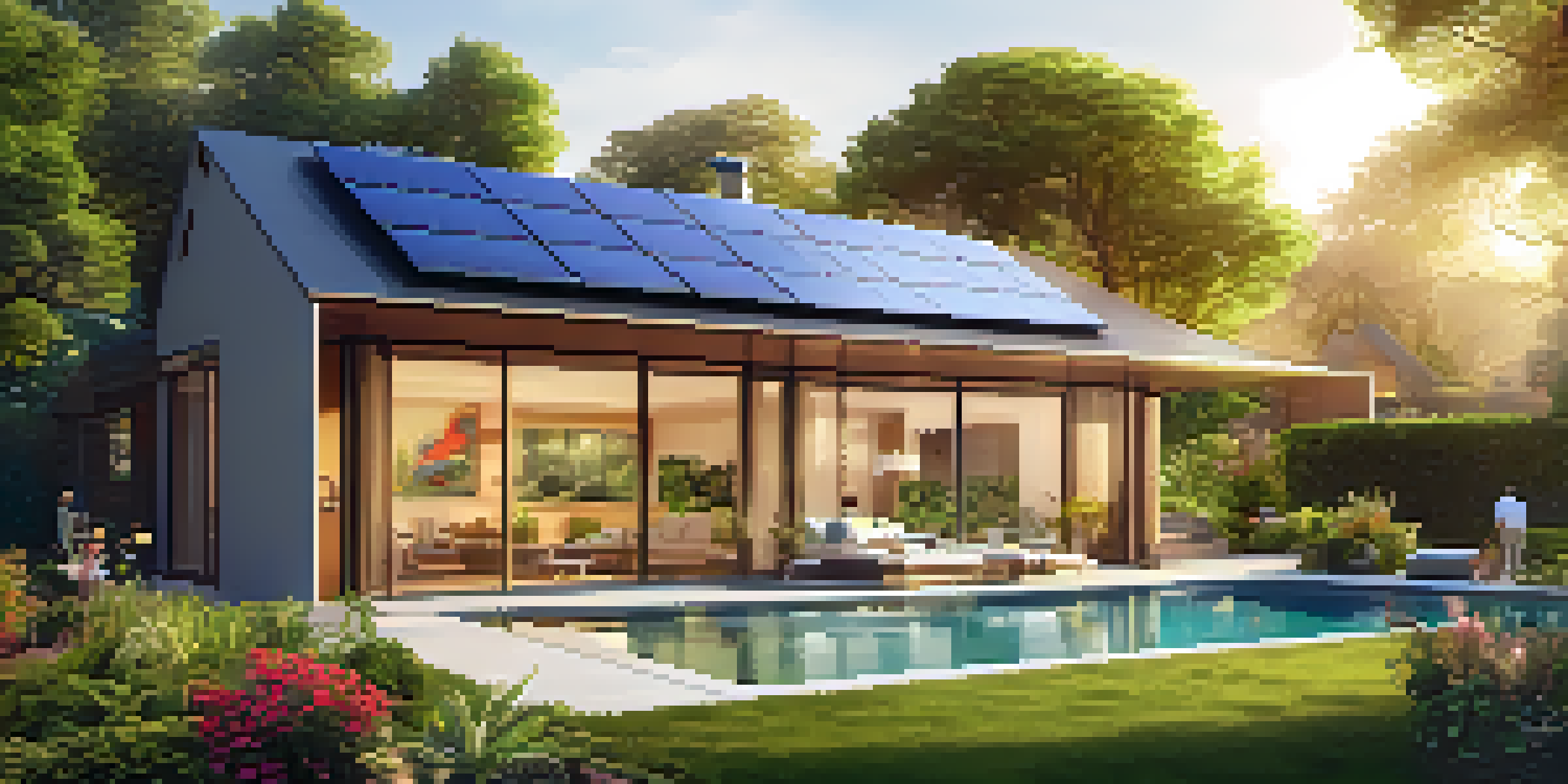The Impact of Energy Efficiency Tax Credits on Homeowners

Understanding Energy Efficiency Tax Credits
Energy efficiency tax credits are incentives provided by the government to encourage homeowners to invest in energy-saving improvements. These credits can significantly reduce the overall cost of upgrading appliances, windows, insulation, and heating systems. By taking advantage of these credits, homeowners not only save money but also contribute to a more sustainable environment.
Energy efficiency is not just about saving money; it's about making smart choices that benefit both our wallets and the planet.
For example, if you install a new energy-efficient furnace, you may qualify for a tax credit that directly reduces your tax bill. This financial boost makes it more appealing for homeowners to make the switch to greener options. In essence, these credits act as a catalyst for homeowners to embrace energy efficiency, making it easier to justify the initial investment.
Moreover, the availability of these credits varies depending on the specific energy-efficient improvements and the current tax laws. Homeowners should stay informed about the eligibility criteria and the application process to maximize their benefits and ensure they're making the most of these valuable incentives.
Financial Benefits of Tax Credits for Homeowners
One of the most immediate benefits of energy efficiency tax credits is the financial relief they provide. When homeowners invest in qualifying upgrades, the tax credits can lead to substantial savings on their tax returns. This effectively lowers the out-of-pocket costs for improvements that would otherwise seem financially daunting.

For instance, if you spend $5,000 on energy-efficient windows and qualify for a 10% tax credit, you could save $500 on your taxes. This means you not only enhance your home's comfort and efficiency but also see a return on your investment almost immediately. Such savings can encourage more homeowners to consider energy-efficient upgrades.
Tax Credits Boost Energy Efficiency
Energy efficiency tax credits incentivize homeowners to invest in upgrades, reducing costs while promoting sustainability.
In addition to the direct tax savings, improved energy efficiency can lead to lower utility bills over time. This dual benefit of tax credits and ongoing savings creates a compelling financial case for homeowners, turning energy efficiency into a wise long-term investment.
How Tax Credits Encourage Sustainable Choices
Energy efficiency tax credits don't just benefit individual homeowners; they also promote sustainable living on a larger scale. By incentivizing energy-saving upgrades, these credits encourage homeowners to think critically about their energy consumption and its impact on the environment. This shift can lead to a collective reduction in energy demand.
The greatest threat to our planet is the belief that someone else will save it.
As more homeowners take advantage of these credits, the cumulative effect can be significant. For example, if thousands of homeowners across a region upgrade to energy-efficient appliances, the overall demand for electricity can decrease, leading to a reduction in greenhouse gas emissions. This is a win-win for both homeowners and the planet.
Moreover, by making sustainable choices more financially accessible, energy efficiency tax credits help foster a culture of environmental responsibility. Homeowners become more aware of their energy usage, leading to more informed decisions that prioritize sustainability, not just in their homes but in their daily lives.
Navigating the Application Process
While the benefits of energy efficiency tax credits are appealing, navigating the application process can sometimes be daunting for homeowners. Understanding what improvements qualify and how to file for these credits is crucial for maximizing benefits. Fortunately, the IRS provides clear guidelines to help homeowners through this process.
To start, homeowners should keep detailed records of their purchases and improvements, including receipts and product information. This documentation is essential when it comes time to file taxes and claim the credits. Additionally, consulting with a tax professional can provide clarity and ensure that all eligible credits are claimed.
Combine Incentives for Maximum Savings
Homeowners can enhance their savings by pairing federal tax credits with local rebates and utility incentives.
It's also important for homeowners to stay updated on any changes to tax laws or available credits, as these can impact eligibility and the types of improvements that qualify. Being proactive in understanding these factors can make the difference between missing out on potential savings and fully benefiting from available tax incentives.
Combining Tax Credits with Other Incentives
Homeowners can amplify their savings by combining energy efficiency tax credits with other local or state incentives. Many regions offer additional rebates or grants for energy-saving improvements, which can complement the federal tax credits. This layered approach can significantly reduce the overall cost of upgrades.
For example, a homeowner in California might benefit from both a federal tax credit and a state rebate for installing solar panels. This combination can turn what might seem like a large initial investment into a more manageable expense, making green upgrades more appealing. It's like stacking coupons for a big sale—every little bit helps!
Additionally, some utility companies offer incentives for energy-efficient practices, providing another opportunity for savings. By researching and understanding the various programs available, homeowners can maximize their financial benefits while making significant strides toward energy efficiency.
Long-Term Benefits Beyond Tax Credits
While energy efficiency tax credits offer immediate financial relief, the long-term benefits extend far beyond tax season. Homeowners who invest in energy-efficient upgrades often enjoy increased home value, as energy efficiency is an attractive feature for potential buyers. This can lead to a higher resale value when it comes time to sell.
Moreover, energy-efficient homes typically require less maintenance and may have a longer lifespan. For example, high-quality insulation and energy-efficient windows can lead to reduced wear and tear on heating and cooling systems. Homeowners not only save on energy bills but also on potential repair costs, contributing to a healthier budget over time.
Long-Term Gains from Energy Upgrades
Investing in energy-efficient improvements not only lowers immediate costs but also increases home value and reduces maintenance.
Lastly, embracing energy efficiency fosters a sense of pride in homeownership. Homeowners can feel good about their contributions to a sustainable future, knowing they're reducing their carbon footprint while enjoying the comfort and cost savings of an energy-efficient home.
Future of Energy Efficiency Tax Credits
The future of energy efficiency tax credits looks promising as governments continue to prioritize sustainability and climate action. As awareness of environmental issues grows, more initiatives aimed at encouraging energy-efficient upgrades may emerge. This could mean increased funding and expanded eligibility for tax credits in the coming years.
Additionally, technological advancements in energy-efficient products will likely lead to new opportunities for tax credits. As innovative solutions become available, homeowners could find even more ways to save on energy costs while benefiting from tax incentives. This evolution will keep the focus on making homes greener and more efficient.

Homeowners should remain optimistic and proactive about these opportunities. Keeping an eye on policy changes and engaging with local energy efficiency programs can help them stay informed and ready to take advantage of future tax credits and incentives.